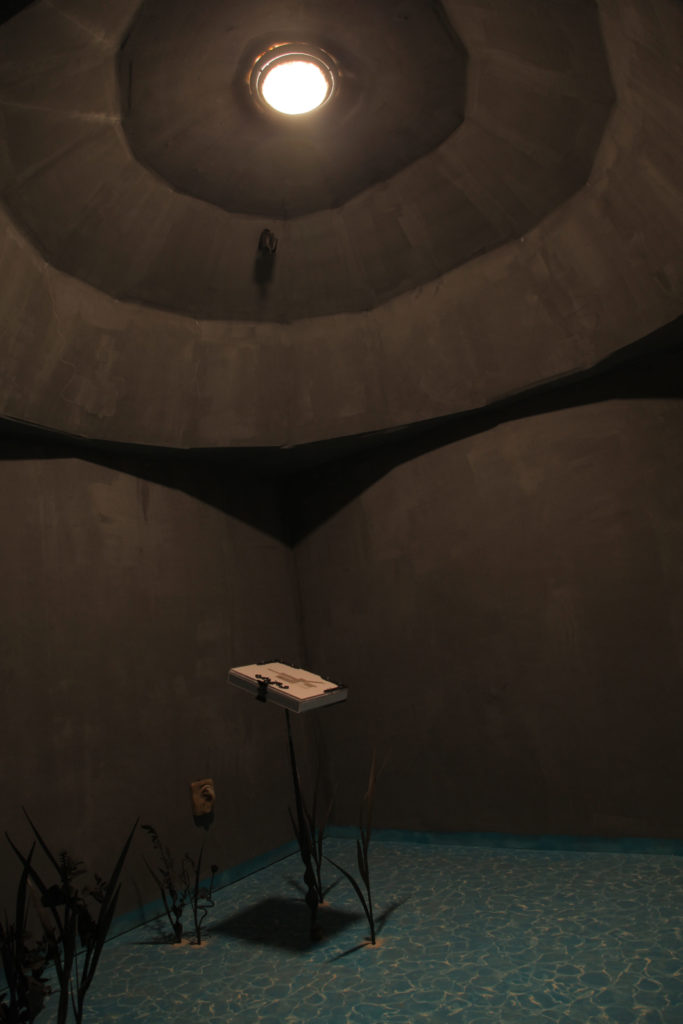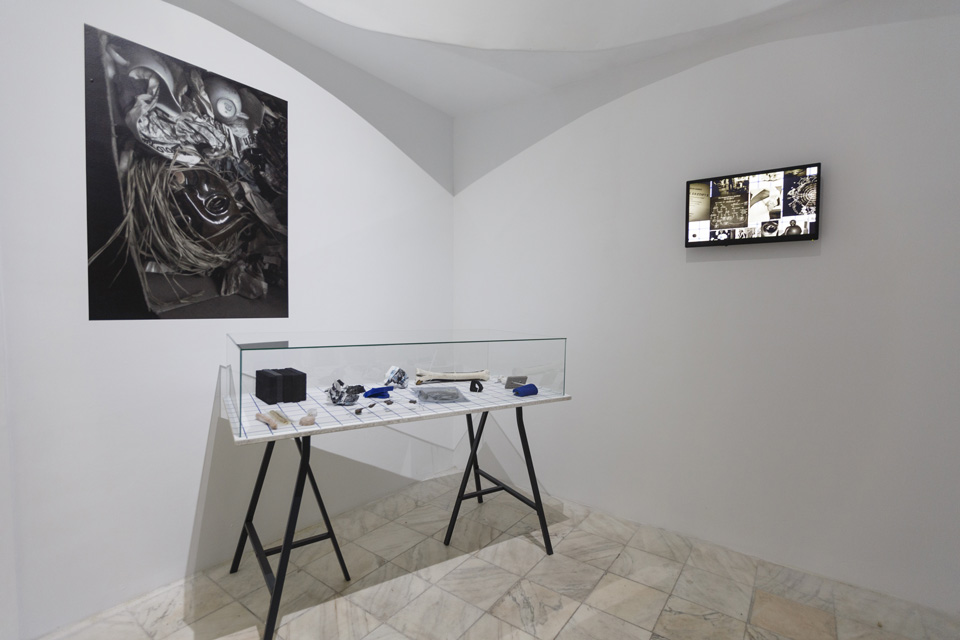Re-framing a space into multiple screens Superliquidato (SPRLQDT) – a hazy story
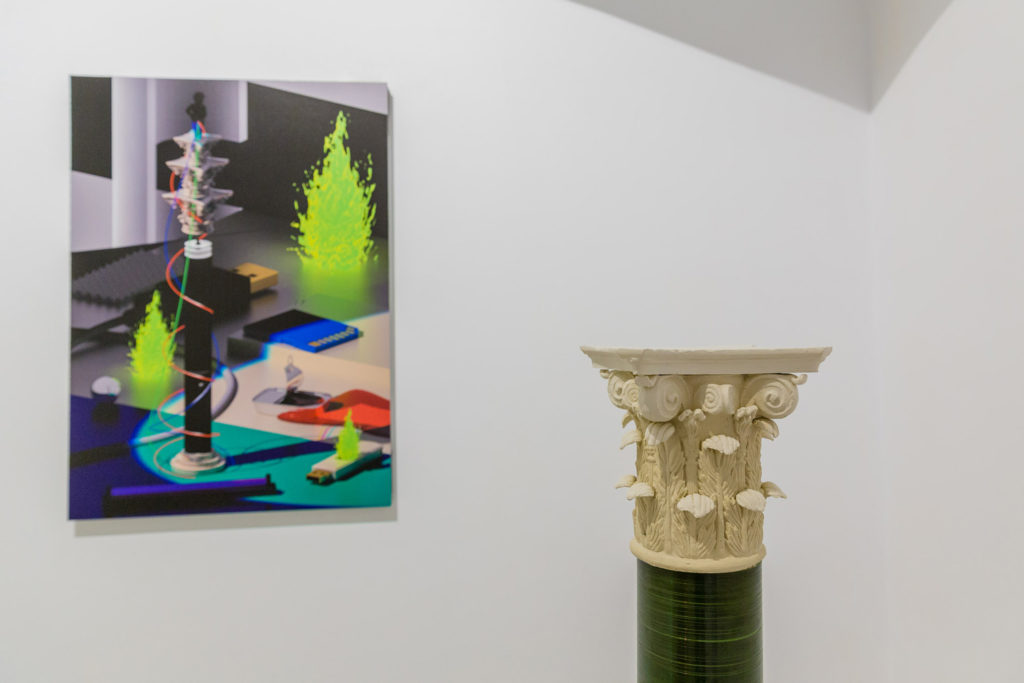
I will write my report as if it was a story, for I was taught in my home-world that truth is a matter of imagination.
– Ursula K. Le Guin
•» It took shape slowly, as from vague memories or a déjà vu feeling surrounding the mysteries of ancient Petra, from the liquid dark waters that flow in the back of the mind, the artificial vegetation grown on tampered land, and the calmness of seducing screens. So appeared the carved but unwritten manuscript of an entity living between digital believes and white plasterboards. I will write its story from the notes persisting after my own burnout, mismatched and from within, always about to reset – a fragmented and incomplete course of events that I cannot retell otherwise. For now.
SPRLQDT presented itself as a capsule space, a backdrop where ideas and practices merging from digital art or derived from it, whether experiments and ‘orthodox’ media, could find a temporary place. For you see, the digital art scene was and still is to coagulate, but back in 2014, finding a platform for it was a constant struggle. Yet, between the hive-mind of the Internet and ideas unfolding in everyday conversations, rummaging through ways of visibility and exasperation, spaces can emerge; like this one, in a dome-like structure, 12 m², an oddity among the artists’ studios and galleries of The Paintbrush Factory in Cluj-Napoca. Mi Kafchin, Maria Balea, and George Crîngașu formed an undisclosed collective – that I later joined –, for which the roles that accompany and divide work practices: artist, curator, gallerist, became irrelevant. As far as my own view of the local scene went, the new digital was less claimed as direction among Romanian art spaces, just a tangential encounter maybe. For SPRLQDT, however, was the primary reference, mostly because within the collective, we were already making use of practices, aesthetic elements, and theoretical concepts derived from it. The data has to flow, and the web can sustain it.
•» What to do with a dome-like structure if not re-frame it?
Spaces that work with atmosphere can live you with the desire to get immersed in other worlds. In this sense, re-framing spaces can function as a simulation for a feeling of the digital world, something that can be transferred InRealLife. This simulation shouldn’t be seen as a ‘trickery,’ instead, it signals the potential of an artificial space to incite, to open an encounter with that which is displayed. Here, the space gets to be played out in a double sense, simultaneously. Once, as in a performative manner, meaning through re-configurations suiting exhibitions. And then, as an extension into an outer or a place without place, the virtual. ‘Fictionalization’ might work as an extra dimension in which one can easily pass through. Glitter, liquid graphics, strawberries, a mock-up baroque chandelier, white marble – all those extras that made SPRLQDT a superfluous entity, relegating it to what we used to call Post-Internet aesthetics.
The digital tools and the artistic practices that make use of them, thinking within the Internet, the web’ structures, how they shape environments and relations in everyday life, sparked not only interest but also a constant shift in terminology. From ‘historicizing’ to theoretical tendencies, in a short time-span, there was a resurfacing of dizzying derivatives from Net Art, New Media, Post-Internet, Net Aesthetics, New Aesthetics, or Post-Digital. Matter of fact remains, these practices reflect on something that has already been integrated into our daily lives. Post-digital, maybe, forerun by Transmediale, revitalizes a sense of political tension against what others have addressed as the sheer bliss of aesthetics. The term engages with the contemporary condition of an ever-expanding technological world dominated by the digital. A fluidity between past and future, the murky life after and in the digital.1
•» Becoming
Tying the knots together in a mashup of material and immaterial, the Internet hive mind can cross us the borders into mythical realms, that do not need localization and instead run on forms of fiction.2Technological devices at the touch of a fingertip, aesthetics environments and structures we create with and through them, make the everyday life and the digital indistinguishable. They dress us up. How do we live within the ‘network’? The excitement of relegating the body in the vast sea of data gets entangled in the dangerous liaisons:
_love/emotion/identity/interiors for a living –
everything is present online.
For ‘everything is present online’ (November 2016), SPRLQDT shifted into a scenography setting, moderated by dim light and (generated) through the fog. Under the dome, it became a medium for the screens to perform, while visitors could step the threshold into the ‘real’ space of exhibiting. Artists Vlad Anghel, Anastasia Manole, Taietzel Ticalos, and Tristan Daniel Nicolas were, in fact, showcasing their work through the NewHive platform for digital art. Visitors were invited to browse their profiles and explore the platform. The line between the screen and the wall kept expanding and almost merging the spaces. It created a digital speculation that, in a voyeuristic act, went from performative odds to objects and interior renderings, to body and economics, and layers of profile identity.
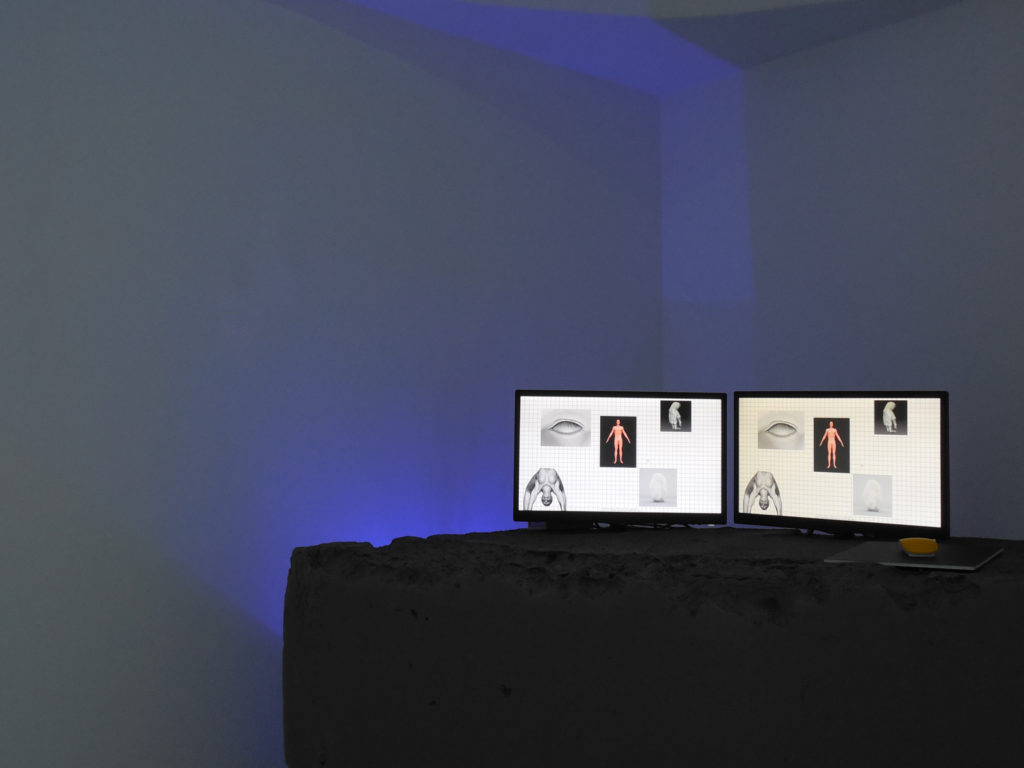
_network / networking / present/ de-localizing/ periphery
The permeability of communities formed around these artistic practices enabled SPRLQDT to become an IRL embassy for the second edition of The Wrong – new digital art biennale. Designed as a curated online platform connecting the virtual pavilions and real-location embassies, the biennale was spilling the virtual into the real and back again. As a web, it connected nods and interference between artists and spaces, different backgrounds, levels of practice, and geographical placement. One of the arch-key of gliding the internet was, one should be reminded, the promise of de-locality.
UV Index – Unresponsive Media3
(December 2015) challenged the 12 m² with a group show that under any
circumstances might have needed properly orchestrated devices. But the power of
the screens is that they can multiply. Between two extended screens and a
projection, SPRLQDT became an immersive audio-visual environment of a polyphony
that in return requested presence and attention. The exhibition was, actuality,
a curated series of works from the platform Undervolt&Co4for
experimental video artists. In the amalgam of visual and audio materials from
25 artists loading ever-more on the screens, the glitches, dislocations,
errors, collapsing interfaces, and the loud noise aimed for a disturbance in
the smoothness with which information media channels accustomed us. They
reflected on the stubbornness devices can manifest in not adjusting. While the
selection offered a glimpse into the multitude of practices digital tools can
facilitate, aiming to create something of a dream world – looking in
retrospective, the show was, however, more seducing and absorbing, than
resistant.
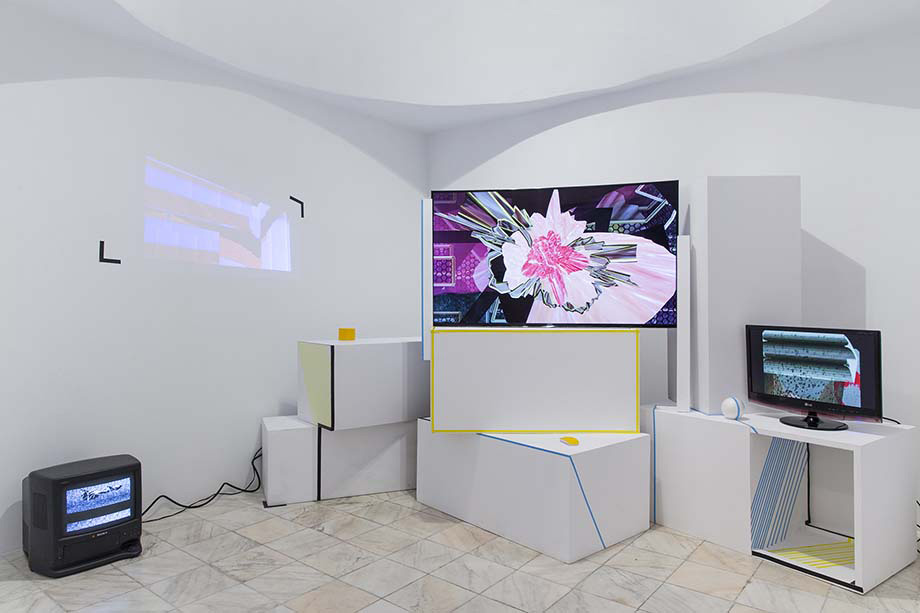
The hype surrounding digital media raised nonetheless a series of questions, more specific on how artworks are transferred from a virtual environment into an actual space; and moreover, how a non-space can be a requisite for display. In its ambivalence of IRL and Online, the biennale involuntary revealed the fractures present in a connection-culture that was supposed to cut across geographical borders and make sharing and databases operate smoothly – to challenge hierarchies. The founder, David Quiles Guilló, running the event from Alicante, Spain, added in an interview that they were showcasing as well in a ‘remote’ city in Romania,5meaning, of course, Cluj-Napoca, through SPRLQDT. Theorist and editor of the contemporary art platform anti-utopias, Sabin Borș, underlined the problematic of it, asking in which way was Cluj-Napoca remote in the first place.6Directed towards an idealized image of ‘the web,’ and especially that language of ‘newness,’ his critique pointed out the exoticization of sites in a similar manner cultural imaginaries do. Sabin Borș was mapping at that time the new habitats for practices dealing with digital arts and the virtual like DiMoDa [The Digital Museum for Digital Arts], art platform Paper Thin or Unplace – ‘a museum without a place.’ Along with other sites, they were forerunners in challenging the limitations of ‘real’ spaces. The discussion reflected how and if these virtual spaces address the institutional issues, or just reproduce the same modus operandi and, at times, cultural stereotypes. As algorithms have often shown, a network remains in touch with the geographies and techniques that distribute our everyday life interactions. In this sense, the screens surrounding us are always on the brink of actualizing the same old.
_the digital tool made sculptural / a material
persistence
When George Crîngașu took over proposing an Artefactual Persistence (March 2016), SPRLQDT transformed into a simulation of a virtual rendering for how an exhibition might be displayed. Even if the 3D got translated into the flat surface of the print, under the dome structure, and having a marble ground holding the works together, it underlined the possibility of another space. In this sense, looking at the ‘obsoleteness’ of storage devices, the show made use of different associations of elements from historical architecture to everyday discarded objects, cables and the abstract encapsulated in geometrical figures. They composed a cross-reference to both an understanding of storage devices as cultural artifacts in themselves and to the processes of archiving objects per se; ultimately, meeting metaphorically in a Corinthian column, a real pillar made of overlaid CDs. Given the speed with which 3D scanning, as a tool for inventory and preservation of artifacts, is gaining momentum offering informational support for artifacts, everyday object, architecture (you name it, and it is scanned), the vulnerability of storage devices remains relevant. As well as their persistence of objects of economic and cultural information about the civilizations creating them. With ‘Arcadia’ (October 2016) however, the show curated by Áron Fenyvesi, featuring the artists Tamás Komoróczky, Ádám Ulbert, and the rising star Agnieszka Polska, it was the language which seemed to defy any sense of representations. The artists’ mythical excursions turn into something abstract, something of poetry, a characteristic that bestows to Polska’s distinct fictionalizations. While myths and nature merged together in a contemporary art quest through post-internet and Anthropocene, as with Crîngașu’s bridging between digital and real artifacts, Tamás Komoróczky inventory of bones, foam, and cables brought the elements back on the (analyzing) table. Everything gets intertwined.
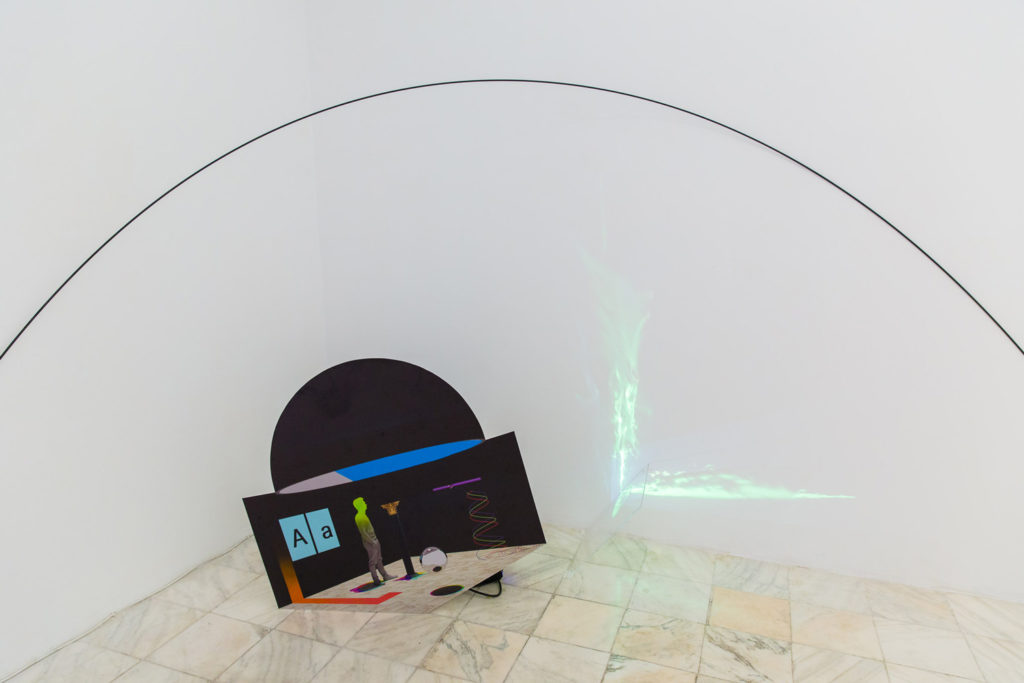
These flowing movements between virtual and concrete,
work as a reminder that a sort of texture always accompanies images, regardless
of their ‘flatness.’ Our bodily perceptions can ‘read’ and recall the textural
of objects and also understand if things can be re-configured otherwise.
Materiality is not only a question of material but of perception or hapticity7
as well, one that can travel from one medium to another.
•» Surfacing – just a short note
Theorists Giuliana Bruno underlined the surface condition as a critical element for what constitutes the fundamental aspect of our contemporary visual culture: ‘the becoming screen.’ Yet, it is not the dissipation of materiality under the age of the digital that holds Bruno’s interested, but ‘the substance of material relations.’ Bypassing the controversy of the medium specificity and, consequently, the ‘obsoleteness’ of devices, what makes the images so appealing might as well be the fluidity through which they move from one media to another. A surface thus extends from the layer of our skin to our surrounding to the architecture of (moving) light. Like a ‘surrounding membrane,’ it engages a mediation between subjects and objects. Both a site of screening and projection, it is embedded with affect. A screen in this sense is a material place of encounter.8
•» Under and Within*9
SPRLQDT circulated and infiltrated itself into the digital arts networks through social media. Part boredom, part neglect, its archive, and identity exists only as a persona not yet under the legal age, connected to an event page, that still retains the ‘thrill and the excitement’ of art talk keeping in/formed. Yet, it gradually started submerging itself in the same water that it appeared from, at a time when professionalization was a question of stability. I might have left in an inopportune moment, but the signs of a rigorous structure we were reproducing against the former fluidity of our ‘entity’ already made themselves present. And regardless of our will, like a now sentient being, SPRLQDT made an act of resistance, of retreat. In a cultural background dependent on forms of subsisting – of the pressure to structure, to produce and continuously advertise oneself to keep afloat – how you can configure a space of fluidity, might be a mystery. But one I still find worth exploring. The digital already lives on the surface of our skin.
Edith Lázár is a fashion theorist in the making and occasional art writer. Her research and wonderings focus on aesthetic politics, fictions as alternative structures of perception and forms of visibility, as well as the imbrications between art, fashion, practice, and the everyday. As an associate editor of the Fashion Series for contemporary art platform anti-utopias, she explored these aspects through book reviews and interviews. Taking an interest in artistic practices, she was a former collaborator of SPRLQDT Art Space and is the co-founder of and part of the curatorial collective Aici Acolo, reactivating unused or abandoned urban spaces in Cluj-Napoca by transforming them into temporary art space showcasing young artists.
Across and Beyond: Post-digital Practices, Concepts, and Institutions – Ryan Bishop, Kristoffer Gansing and Jussi Parikka, 2016, https://transmediale.de/content/across-and-beyond-post-digital-practices-concepts-and-institutions
Ingrid Loschek, When Clothes Become Fashion: Design and Innovation Systems, Berg, 2009, p.126
Mediated by: Davide Quilles Guiló/ Curated by: Yoshi Sodeoka, Johnny Woods & Rea McNamara/ Artists: Carrie Gates, Extreme Animals, Sabrina Ratté, Camilla Padgitt-Coles, Brandon Blommaert, Robert Beatty, E*Rock, Eva Papamargariti, Peter Burr, Suzy Poling, Emilio Gomariz, Javier Galán Rico, Adam Ferriss, Andrew Benson, MSHR, A. Bill Miller, Rick Silva, Spectral Net, Cristopher Cichocki, Giselle Zatonyl, Jimmy Joe Roche, Johnny Woods, Jenifer Juniper Stratford, Yoshihide Sodeoka, Ryoya Usuha/ The Wrong (again) –New digital art biennial, 2015-2016
Talking about the second edition and its extension, Guilló stated: “We’re in some unexpected locations too. We’re building a show in a remote city in Romania, which is an amazing addition!” http://artfcity.com/2015/10/29/launching-the-largest-digital-biennale-in-the-world-on-shoestring-budget-an-interview-with-david-quiles-guillo/See also related materials to the article.
Sabin Borș, DiMoDA: The Digital Museum of Digital Art. A Virtual Institution https://anti-utopias.com/newswire/dimoda-digital-museum-digital-art/See also related materials to the article.
Sophie Woodward, Tom Fisher, Fashioning through materials: Material culture, materiality, and processes of materialization, in Critical Studies in Fashion and Beauty, Vol. 5, Nr. 1, 2014
Giuliana Bruno, Surface: Matters of Aesthetics, Materiality, and Media, University of Chicago Press, 2017
*the events recalled here are just a fragment of SPRLQDT’s existence, there are things before and in-between and an after. The art space was active between 2014 and 2017, and has had a consistent set of displays, proposals, activities, and exhibitions that transformed, modulated, and re-framed it: https://www.facebook.com/sprlqdt
